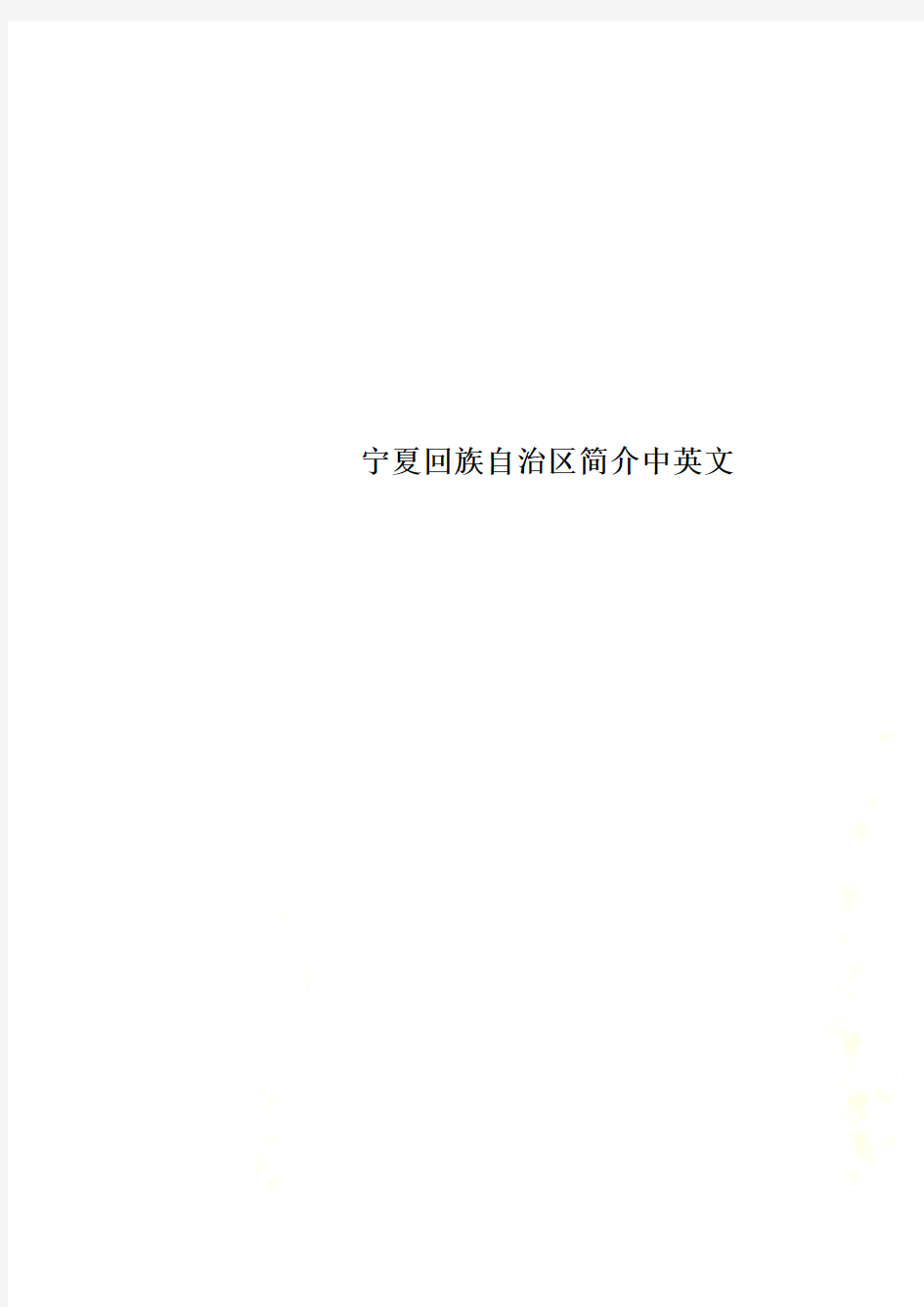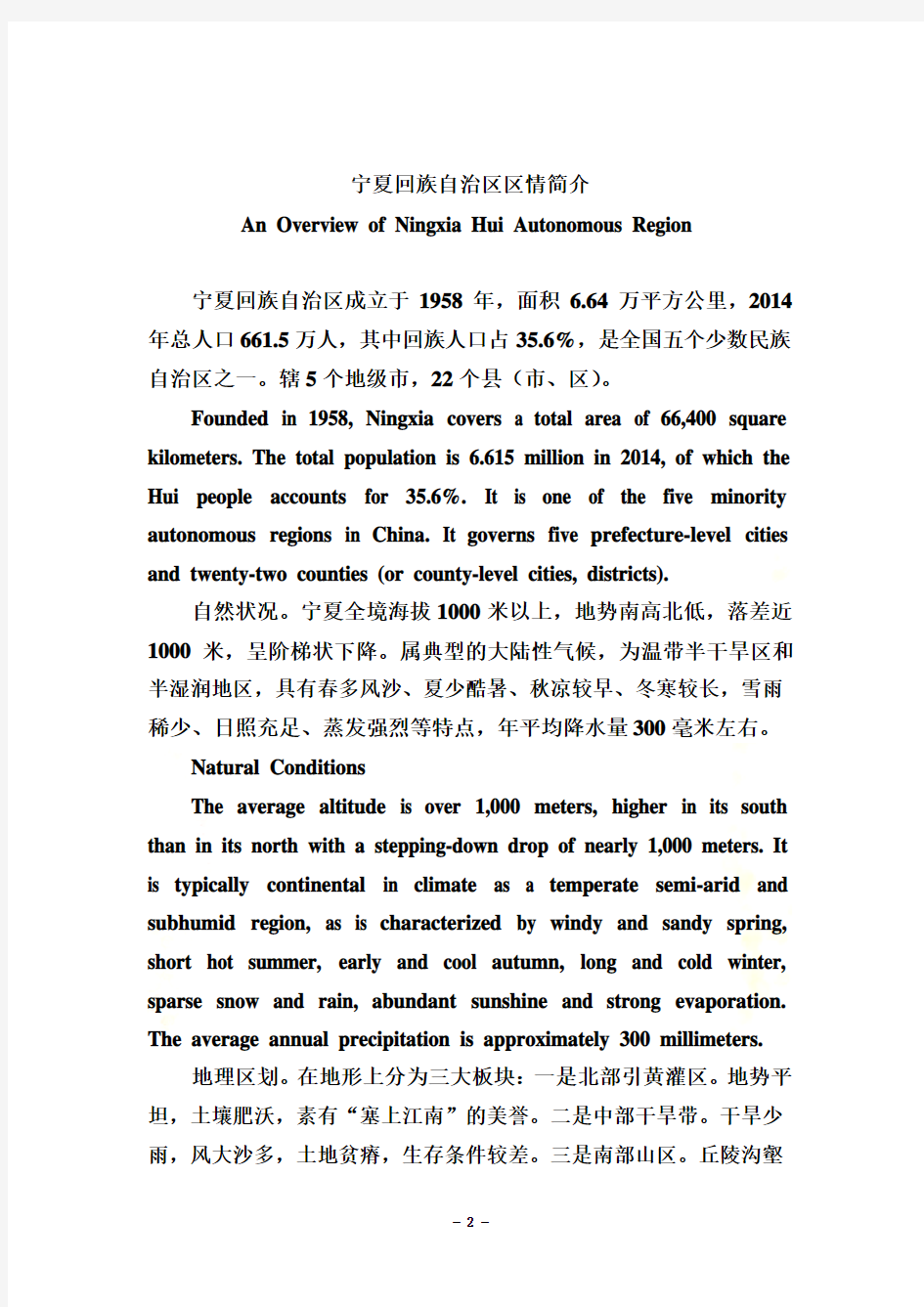宁夏回族自治区简介中英文


宁夏回族自治区简介中英文
宁夏回族自治区区情简介
An Overview of Ningxia Hui Autonomous Region
宁夏回族自治区成立于1958年,面积6.64万平方公里,2014年总人口661.5万人,其中回族人口占35.6%,是全国五个少数民族自治区之一。辖5个地级市,22个县(市、区)。
Founded in 1958, Ningxia covers a total area of 66,400 square kilometers. The total population is 6.615 million in 2014, of which the Hui people accounts for 35.6%. It is one of the five minority autonomous regions in China. It governs five prefecture-level cities and twenty-two counties (or county-level cities, districts).
自然状况。宁夏全境海拔1000米以上,地势南高北低,落差近1000米,呈阶梯状下降。属典型的大陆性气候,为温带半干旱区和半湿润地区,具有春多风沙、夏少酷暑、秋凉较早、冬寒较长,雪雨稀少、日照充足、蒸发强烈等特点,年平均降水量300毫米左右。
Natural Conditions
The average altitude is over 1,000 meters, higher in its south than in its north with a stepping-down drop of nearly 1,000 meters. It is typically continental in climate as a temperate semi-arid and subhumid region, as is characterized by windy and sandy spring, short hot summer, early and cool autumn, long and cold winter, sparse snow and rain, abundant sunshine and strong evaporation. The average annual precipitation is approximately 300 millimeters.
地理区划。在地形上分为三大板块:一是北部引黄灌区。地势平坦,土壤肥沃,素有“塞上江南”的美誉。二是中部干旱带。干旱少雨,风大沙多,土地贫瘠,生存条件较差。三是南部山区。丘陵沟壑
林立,部分地域阴湿高寒,是国家级贫困地区之一。
Geographical Conditions
The whole region can be divided into three sections. The northern Yellow River irrigation area, featuring smooth plain and fertile soil, has long enjoyed the fame of “An Oasis in the Hinterland”. The middle arid area, dry, windy and sandy, is known for its barren land and poor living conditions. The southern mountainous area, dominated by hills and ravines, cold and humid in part, is one of the poverty stricken areas in China.
历史沿革。宁夏是中华远古文明的发祥地之一。早在3万年前就有人类活动,创造了旧石器晚期的“水洞沟文化”。战国秦昭襄王三十五年(公元前272年)设北地郡。秦始皇统一中国后,宁夏北部首次纳入中央版图。西晋末年,匈奴人赫连勃勃建立地方政权,自号夏,宁夏属其管辖范围。唐朝,在灵州(今宁夏灵武)设大都督府和朔方节度使。1038年,党项族首领李元昊以宁夏为中心建立大夏国,史称西夏,定都兴庆府(今银川市)。1227年,蒙古灭西夏后,取“安宁”之意,改名“宁夏”。明朝设宁夏卫,清朝设宁夏府。民国初年设朔方道,1929年成立宁夏省。1954年宁夏省撤销并入甘肃。1949年9月23日宁夏解放,1958年10月25日成立宁夏回族自治区,首府银川市。
Historical Evolution
Ningxia is one of the origins of Chinese civilization. About 30,000 years ago, there were human habitats already, with indications at the Shuidonggou Paleolithic Site and the Caiyuan Village Site. Zhaoxiang Emperor established the Beidi Shire in the 35th year (272 BC) of the Qin Dynasty. After Qinshihuang unified China, the northern part of Ningxia was incorporated into the Chinese territory for the first time.
堡、镇北堡、古长城)、“两文一景”(西夏文化、回族文化、塞上江南景观),体现了深厚的文化底蕴,展示着独特的自然风光。“塞上江南·神奇宁夏”旅游形象日益叫响,吸引着越来越多的中外游客。
Resource Advantages
Compared with other places, Ningxia boats obvious advantages in its agriculture, energy, tourism, etc, which enjoy great potential for development. Firstly, it is the agricultural advantage. Ningxia now has 16.5 million mu (15 mu=1 hectare) of arable land, or 2.8 mu per capita, ranking the second place in China; it has 7.9 million mu of arable land with the Yellow River irrigation, making it one of the 12 grain production bases in China. Furthermore, with 36.65 million mu of grassland, it is one of China’s ten biggest pastures. Secondly, it is the energy advantage. Ningxia boasts 4 billion cubic meters of usable water from the Yellow River, accounting for 7% of the total distribution water amount; it ranks the 6th in China in terms of its proven coal reserves of 46.9 billion tons, of which Ningdong coal field boasts 39.3 billion tons and is enlisted as one of China’s 14 large coal bases. It has more than 50 proven mineral resources, the potential value of natural resources per capita here is 163.59% of the national average value, ranking the 5th in China. Thirdly, it is the tourism advantage. The ancient Yellow River civilization, mysterious Western Xia history, distinct Hui customs and magnificent scenes of the desert have contributed to the diversified tourism resources here. Profound cultural foundation and unique natural beauty can be embodied and appreciated in “two mountains and one river” (the Helan Mountains, the Liupan Mountains and the Yellow River), “two sands and one
